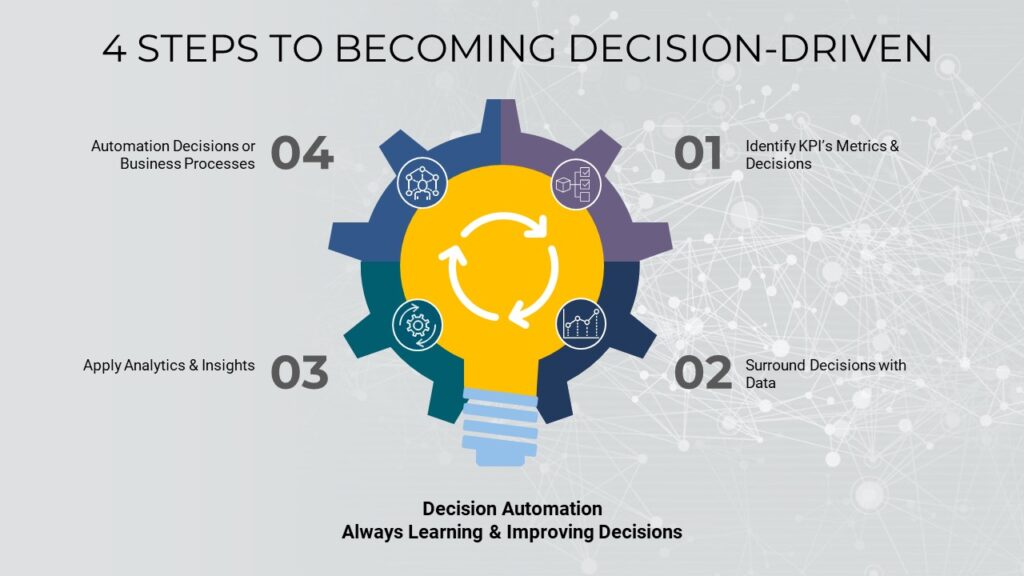4 Key Steps to Automating Decisions
Posted: April 3, 2023
Decision Automation Begins with Understanding Your Business
There are many key foundational capabilities that are part of being data-driven. Through years of experience implementing AI/ML (Artificial Intelligence/Machine Learning), data, and analytic programs we have seen and heard a lot from our great customers. It wasn’t until recently that one of our clients, a wise CDO, said something that really got us thinking.
“I want to find all decisions, surround them with data, and apply AI,” he said.
He boiled it all down to the value of making informed decisions. He knew that data-driven decisions are the key to understanding how to improve the business. Doesn’t matter if it’s sales, supply chain, customer service, or marketing; data should be at the heart of every business decision. It’s just that simple.
His key phrase helped us simplify how we put that into practice and make it a reality for our clients. We’ve grouped the actions into four steps and want to share that with you so that you can understand what it takes to become a data-driven organization and make more informed decisions. It looks like this:

- Identify Metrics, KPIs, and Decisions. You have to know your business. Taking an enterprise view and identifying the most important area is the first step to scoping your initiative. This is critical and may be one of the hardest things to do. Remember, you cannot do everything out of the gate, so determining priorities and looking at your organization’s overall goals is an important step. This is something that is typically done during the Roadmap, discussed in our first newsletter. Perhaps it’s improving customer service scores, increasing market share, or even becoming a more sustainable company. Scoping and identifying an area to focus on is your first task.Once that is narrowed down, define the problem by identifying the metrics that move the needle. Understand all of the questions that need to be answered and the decisions that need to be made. For example, one question might be “are you gaining market share over time?” A decision to be made might be whether to adjust pricing dynamically to stay current or ahead of the market.Now comes the drill down. Brainstorm around these metrics and processes needed to help answer these questions and drive your decisions. These are often represented as key performance indicators or KPIs. KPIs typically consist of calculations of multiple metrics. Customer churn, for example, is typically a calculation of new subscribers minus canceled subscribers plus and reactivated subscribers. Making a list of all the metrics you need to support your KPIs will help you define the data and analytics you require. This boils down to understanding your business, your goals, and the levers (decisions) you have at your disposal to improve and automate your business.
- Surround the Decisions with Data. Learn which systems have the data you will need to support your metrics/decisions. There will likely be several. Start by creating a unified or single view of the data you need. That may be in the form of a data warehouse but, some technologies today allow you to view and analyze data in place. Pay close attention to the quality of the data as this can really impact your results.As you become more familiar and comfortable with the data, it’s time to increase the granularity or detail. Look at ways to enrich the data with hierarchies, business terms, 3rd party data, and begin creating a historical record. This is what really makes the data valuable.
- Apply Analytics & Insights. Here’s where it gets fun. Data can really tell a story—one that you might not see otherwise. Start by analyzing your KPIs. Look at them over time to identify peaks and valleys and try to understand what you are seeing. Is it seasonality? Is it a specific product or customer? Is it from an outside source, such as weather, inflation, or supply chain issues? Track the trends over time, perhaps in a dashboard, and determine if 3rd party data might be needed to identify leading and lagging indicators. All of these will help flush out the root cause and help you make more informed business decisions.As you progress in skills and capabilities, you will identify not only the root causes but what drives both positive and negative outcomes. Once you have a handle on outcomes, you can begin to use data science to bring in AI/ML, such as descriptive and predictive statistical models. These will bring out correlations you won’t be able to see with the naked eye. You may learn which types of customers prefer certain products and use that knowledge to market to new customers. Predictive models will forecast trends into the future based on the past.
- Automate Decisions & Business Processes. So, here’s where the rubber really meets the road. Use your analytics and statistical models as the basis for making business decisions. Not only will your business decisions be based on your metrics and KPIs, but they will be used to influence or even change your underlying business processes.It’s time to incorporate these metrics into your workflows so that decisions are made automatically. Your dashboards have enough detailed metrics that users can take action on what they see. Your models will continue to evolve automatically through what is called machine learning.
By incorporating data, analytics, and the outcomes from analytics and statistical models directly into your business processes, decisions and actions can be done without human intervention. For example, if models show that a particular type of customer will respond to a certain promotion, customer service would automatically be shown whichever promotion is best for the type of customer that called.
So, the wise CDO we spoke of certainly understood the value of data and AI. He also saw it simply as a way of doing business today. Yes, the devil is in the details. But, start small, learn as you go, and get help from experts who have been there and done that.
When it comes to data-driven decision-making, how is your company making decisions? Contact us today to learn how our experience and expertise can support your organizational goals.







